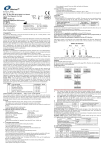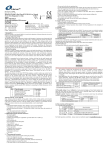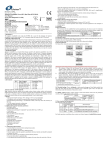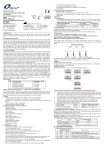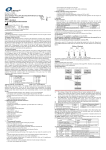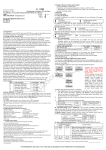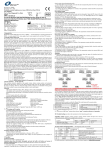Transcript
Revision No.: ZJ0008 Issue Date: Jul 1st, 2012 Yellow Head Virus (YHV) Real Time RT-PCR Kit User Manual For In Vitro Diagnostic Use Only AR-0201-01 For use with LightCycler1.0/2.0 Instrument Shanghai ZJ Bio-Tech Co., Ltd. www.liferiver.com.cn Tel: +86-21-34680596 [email protected] Fax: +86-21-34680595 nd 2 floor,No.15 Building,No.188 Xinjunhuan Road, PuJiang Hi-tech Park, Shanghai, China 1. Intended Use YHV real time RT-PCR kit is used for the detection of Yellow Head Virus(YHV)in gill or muscle samples of shrimp by real time PCR systems. 2. Principle of Real-Time PCR The principle of the real-time detection is based on the fluorogenic 5’nuclease assay. During the PCR reaction, the DNA polymerase cleaves the probe at the 5’ end and separates the reporter dye from the quencher dye only when the probe hybridizes to the target DNA. This cleavage results in the fluorescent signal generated by the cleaved reporter dye, which is monitored real-time by the PCR detection system. The PCR cycle at which an increase in the fluorescence signal is detected initially is proportional to the amount of the specific PCR product. Monitoring the fluorescence intensities in real-time allows the detection of the accumulating product without having to re-open the reaction tube after the amplification. 3. Product Description Yellow-head virus or YHV is a pleomorphic, enveloped virus with single stranded RNA of positive polarity, primarily localized in the cytoplasm of infected cells. YHV is known to occur in wild shrimp populations but the extent of its distribution in wild populations is not known. Viral replication seems to occur only in the cytoplasm without any sign of replication in the intact nuclei of infected cells. A long filamentous form of the virus (some over 800 nm in length), perhaps a precursor to the enveloped, rod-shape form is present in the cytoplasm of many cells. Viral envelopes appear to be acquired by passage of these provirions through the endoplasmic reticulum of the host cells. Enveloped virions then cluster in cytoplasmic vesicles, sometimes densely packed, resembling paracrystalline arrays, where they appear to divide into the smaller rod-shaped units. YHV real time RT-PCR kit contains a specific ready-to-use system for the detection of yellow head virus by Reverse Transcription Polymerase Chain Reaction (RT-PCR) in the real-time PCR system. The reaction is done in one step real time RT-PCR. The first step is a reverse transcription (RT), during which the YHV RNA is transcribed into cDNA. Afterwards, a thermostable DNA polymerase is used to amplify the specific gene fragments by means of polymerase chain reaction (PCR). Fluorescence is emitted and measured by the real time systems´ optical unit during PCR. The detection of amplified YHV cDNA fragment is performed in fluorimeter channel 530nm with the fluorescent quencher BHQ1. In addition, the kit contains a system to identify possible PCR inhibition by measuring the 560nm fluorescence of the internal control (IC). 4. Kit Contents Ref. Type of reagent Presentation 25rxns 1 YHV Super Mix 1 vial, 350ml 2 RT-PCR Enzyme Mix 1 vial, 28ml 3 Molecular Grade Water 1 vial, 400µl 4 Internal Control 1 vial, 30µl 5 YHV Positive Control 1 vial, 30µl 4 Analysis sensitivity: 1×10 copies/ml Note: Analysis sensitivity depends on the sample volume, elution volume, nucleic acid extraction methods and other factors .If you use the RNA extraction kits recommended, the analysis sensitivity is the same as it declares. However, when the sample volume is dozens or even hundreds of times greater than elution volume by some concentrating method, it can be much higher. 5. Storage • All reagents should be stored at -20°C. Storage at +4°C is not recommended. • All reagents can be used until the expiration date indicated on the kit label. • Repeated thawing and freezing (> 3x) should be avoided, as this may reduce the sensitivity of the assay. • Cool all reagents during the working steps. • Super Mix should be stored in the dark. 6. Additionally Required Materials and Devices • Biological cabinet • Real time PCR system • Desktop microcentrifuge for “eppendorf” type tubes (RCF max. 16,000 x g) • Vortex mixer • RNA extraction kit • Real time PCR reaction tubes/plates • Cryo-container • Pipets (0.5 µl – 1000 µl) • Sterile filter tips for micro pipets • Sterile microtubes • Disposable gloves, powderless • Biohazard waste container • Refrigerator and freezer • Tube racks 7. Warnings and Precaution • Carefully read this instruction before starting the procedure. • For in vitro diagnostic use only. • This assay needs to be carried out by skilled personnel. • Clinical samples should be regarded as potentially infectious materials and should be prepared in a laminar flow hood. • This assay needs to be run according to Good Laboratory Practice. • Do not use the kit after its expiration date. • Avoid repeated thawing and freezing of the reagents, this may reduce the sensitivity of the test. • Once the reagents have been thawed, vortex and centrifuge briefly the tubes before use. • Prepare quickly the Reaction mix on ice or in the cooling block. • Set up two separate working areas: 1) Isolation of the RNA/ DNA and 2) Amplification/ detection of amplification products. • Pipets, vials and other working materials should not circulate among working units. • Use always sterile pipette tips with filters. • Wear separate coats and gloves in each area. • Do not pipette by mouth. Do not eat, drink, smoke in laboratory. • Avoid aerosols. 8. Sample Collection, Storage and transport • Collected samples in sterile tubes. • Specimens can be extracted immediately or frozen at -20°C to -80°C. • Transportation of clinical specimens must comply with local regulations for the transport of etiologic agents 9. Procedure 9.1 RNA-Extraction RNA extraction kits are available from various manufacturers. You may use your own extraction systems or the commercial kit based on the yield. For the RNA extraction, please comply with the manufacturer’s instructions. The recommended extraction kit is as follows: Nucleic Acid Isolation Kit Cat. Number Manufacturer RNA Isolation Kit ME-0010/ME-0012 ZJ Biotech QIAamp Viral RNA Mini extraction Kit (50) 52904 QIAGEN 9.2 Internal Control It is necessary to add internal control (IC) in the reaction mix. Internal control (IC) allows the user to determine and control the possibility of PCR inhibition. Add the internal control (IC) 1µl/rxn and the result will be shown in the 560nm. Attention: A. Mix thoroughly before next transfer. B. The positive control contains high concentration of the target DNA. Therefore, be careful during the dilution in order to avoid contamination. 9.3 RT-PCR Protocol The Master Mix volume for each reaction should be pipetted as follows: ※PCR system without 560nm channel may be treated with 1µl Molecular Grade Water instead of 1µl IC. 1) The volumes of Super Mix and Enzyme Mix per reaction multiply with the number of samples, which includes the number of controls, and sample prepared. Molecular Grade Water is used as the negative control. For reasons of unprecise pipetting, always add an extra virtual sample. Mix completely then spin down briefly in a centrifuge. 2) Pipet 15µl Master Mix with micropipets of sterile filter tips to each of the real time PCR reaction plate/tubes. Separately add 5µl RNA sample, positive and negative controls to different reaction plate/tubes. Immediately close the plate/tubes to avoid contamination. 3) Spin down briefly in order to collect the Master Mix in the bottom of the reaction tubes. 4) Perform the following protocol in the instrument: 45°C for 10min 1cycle Selection of fluorescence channels 95°C for 15min 1cycle 530nm Target DNA or RNA 95°C for 5sec, 60°C for 30sec 560nm IC 40cycles ( Fluorescence measured at 60°C) 10. Threshold setting: Choose Arithmetic as back ground and none as Noise Band method, then adjust the Noise band just above the maximum level of molecular grade water, and adjust the threshold just under the minimum of the positive control. 11. Quality control: Negative control, positive control and internal control must be performed correctly, otherwise the sample results is invalid. Channel Crossing point value Control 530nm 560nm Molecular Grade Water Blank 25~35 Positive Control(qualitative assay) ≤35 —— 12. Data Analysis and Interpretation The following results are possible: Crossing point value 530nm 560nm 1# Blank 25~35 2# ≤38 —— 3# 25~35 38~40 4# Blank Blank Result Analysis Below the detection limit or negative Positive Re-test; if it is still 38~40, report as 1# PCR Inhibition; no diagnosis can be concluded. For further questions or problems,please contact our technical support at [email protected]
